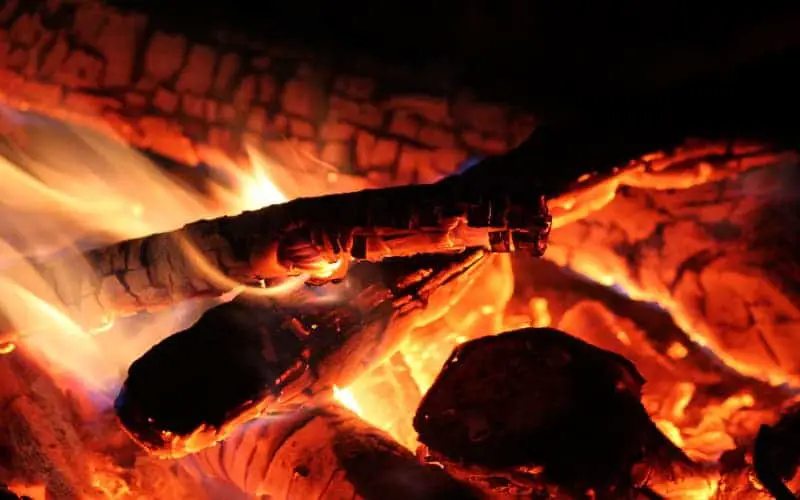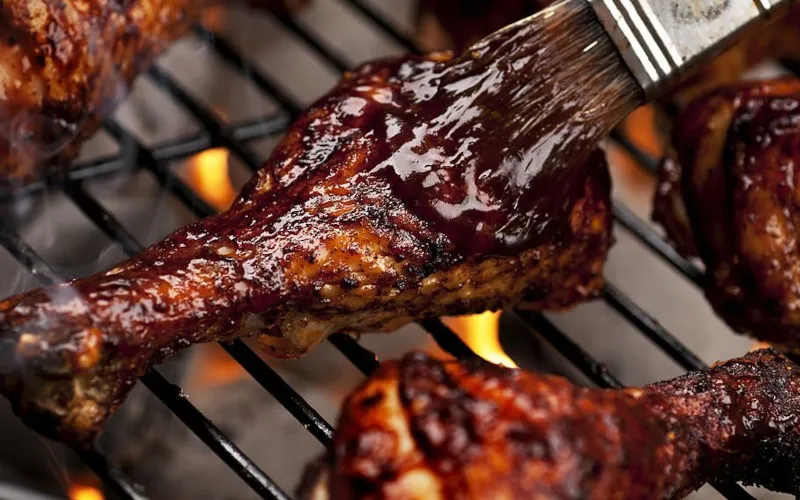You may wish to clean the grill and remove the grease and moisture before leaving your grill unused for some time. Unfortunately, it is possible to store your grill when damp leading to mold growth. Molds grow in a damp, warm space with poor ventilation and can invade your grill.
So, how do you eradicate mold on your grill? Here is how to eliminate mold on the grill when it is affected by mold and how to deal with the molds.
What is Grill Mold?
Mold is a fungus made of multi-cellular thread-like structures that can grow in moist places with poor ventilation. Mold can grow on any grill type as long as it is damp and has poor ventilation. Mold has different colors, textures, and smells, and some can be very harmful to humans.
A few mold spots will not damage your appliance, but an overgrowth might mess with the electronic wire connections.
Moreover, some mold species cause food poisoning, and if you were to cook your food without cleaning out the mold, you might get sick. Mold has a distinct smell, and if you think the whitish matter in your grill is mold, you can clean it out to prevent food poisoning and keep your appliance in an excellent working condition.
The mold will not discriminate the type of grill you own as it grows in the charcoal or pellet smoker.
How Do You Keep a Gas Grill From Getting Moldy?
You can keep the grill free from molds by maintaining a high standard of cleanliness; you should keep the grill pristine. The grill cover is likely to trap water, creating an environment the molds would love. Thus, if the grill cover smells funny, you can turn it inside-out, scrub it with a gentle warm water brush, and bleach it.
Bleaching kills all the fungi destroying the pores, thus eliminating the invasion. You should let the lid dry completely before reattaching. The internal grill parts should be dry, as cleaning the lid alone will not eliminate the issue.
Sometimes mold growth might persists after cleaning the top lid; you can store the grill without its lid in a well-ventilated room. A shed would be ideal for storing the grill without its lid as it prevents moisture seepage into the grill. You may take the grill lid off during a sunny day and let the appliance air out to dry out any moisture trapped inside.
Mold might not grow in a cold climate significantly when the temperature drops, but your appliance might be prone to invasion during autumn and spring. You will not worry about mold growth during the winter as the mold will not survive in a cold space. Thus you should ensure the grill is dry during the spring and summer seasons, as the molds will thrive due to the warmth.
Moreover, you may prevent spores from attaching and growing into molds in your grill using heat. You can superheat your grill once in a while. You can superheat the appliances for ten minutes as it burns off any food particles and water left on the grill. Heat kills the mold spores avoiding mold growth.
Molds can spread from the grill to other damp places in the room, leading to an infestation.
Work on the grill interior burning off the food residues. Use a plastic putty knife to scrape any residues, food, and excess charcoal as they might contribute to mold growth. Mold grows well with a food supply that sustains it, and the grease provides an adequate food supply.
You can wash the grill after removing the residue and wipe off any particles.
Ensure the grill’s interior lid is dry before placing the cover; you can let the grill stay without the lid for some time. You can open all the vents and take away any side pieces to allow better aeration allowing additional moisture trapped in the grill to escape.
Moreover, opening the vents keeps the grill free from moisture from the room. Even if moisture seeps into the run into the grill, it will escape without damage. You should only close the lid when the grill interior is dry and allow for air circulation.
How Do You Get Mold Off Of Grill Grates?
- Disassemble the grill
You can remove the mold from the hard-to-reach parts of the grill by disassembling the unit. You should follow your manual when disassembling the grill to keep it in good condition after cleaning. Disassembling the grill makes it possible to remove any charcoal, lava rocks, ceramics briquettes, and other porous material.
Related: How to Put Out a Charcoal Grill
The porous material can soak water and grease, which leads to mold build-up. Moreover, since the charcoal might have fly-off particles which can irritate the nose and mouth, you would wear a mask. The dust might trigger an allergic reaction for people prone to allergies.
- Mix the grill cleaner
You use a regular cleaner, but baking soda and water mixture will clean the appliance grates effectively. Soapy warm water can clean your grill effectively, but it is better to use effective cleaners which remove the mold. The soapy water will remove the grease, oil, and dampness.
The baking soda solution soaks the grease and food particles; you can use a basting brush to eliminate the grease and food particles. You may use a vinegar solution to clean the grill, but it would be wise to dilute the vinegar solution to avoid dissolving the metallic grates. A stiff brush as it leaves marks on your grill.
- Use heat
You can use heat to kill the molds in the grill. However, you may need to clean the mold and remove food particles before exposing the grill to high heat. You should use a decent amount of heat to remove the moisture and grease from the grill.
After heating the grill, you should not scrape and wash the mold as you would inhale the spores or spread it into your home. You may risk having mold invasion in other areas in the house prone to dampness.
- Let the grill cool down
After heating the grill, you will let it cool down before scraping the grease, oil, and food particles. A grill scraper would clean your appliance effectively; cleaning the grill while hot might lead to metal leaking, pitting, and damage to the grill. The grill expands when hot and pouring water on the grill can lead to sudden contraction, affecting the appliance.
A pressure washer would also clean your appliance effectively, but you would use your elbow energy to scrub the grill if you don’t have the appliance.
However, when cleaning a grill with a porcelain coating, you should avoid a rough scrubber on the surface. You need to avoid strong solutions such as vinegar as it corrodes the surface.
- Wash the grill
After scrubbing all the water from the grill, you can wash it with warm and soapy water. It is possible to have grease particles still attached to the grill. You may use a soft cloth to clean off the grease. You should ensure everything is washed down and the grill is clean and free from particles.
A wire brush might leave rouge wires which become a choking hazard, and you should ensure you eliminate all the wires from the grates. You should remove any particles left behind after scrubbing and cleaning the grill.
A soft cloth will remove all the particles; thus, you should wipe the grill to remove debris that remains after cleaning the grill.
- Fire up the BBQ one more time
You should ensure the appliance is completely clean before firing it once again. Superheating the grill removes any soap, moisture, and grease particles.
Sometimes you may think you have cleaned the BBQ effectively, but you have not reached all the corners; the molds might not die off. Moreover, if there are any mold spores, the fire will eradicate them. The final firing reduces the possibility of mold build-up in the future.
Is It Safe to Use a Grill With Mold?
It might not be safe to use a grill with mold as some mold species might be unhealthy for human consumption. Therefore, it is better to remove any molds on the grill to avoid food poisoning. However, some mold species might be harmless, and even if you use a grill with the mold species, it will not be harmful to your health.
Cooking food with a grill that contains mold leads to a change in flavor as the molds infuse their flavor into the meat, losing the beefy flavor. Thus, to avoid food contamination from the mold invasion, you should clean the grill.
What Temperature Kills Grill Mold?
You can use high temperatures to kill the grill molds. 400 degrees Fahrenheit will kill the molds, but you would preheat the grill to 250 degrees Fahrenheit for 15 minutes before cooking. You may need to remove any visible mold growths, grease, and oil and wipe water before heating the grill to kill the molds.
Does Heat Kill Mold on a Grill?
Heat kills mold spores as long as you use high heat on the grill. However, the molds might be hard to kill as they spread to other house parts. Thus, you can kill the molds by heating them molds at 140 degrees Fahrenheit.
Heating the grill will loosen the baked-on debris and old oil, leading to better mold management. Moreover, even if the heat does not kill the spores, it detaches from the grill, making it easy to scrub them from the surface.
Frequently Asked Questions
Can You Burn Mold Off?
You can burn mold off the grill to avoid food contamination and kill the molds at 140 degrees Fahrenheit. You should preheat the grill for ten minutes at 250 degrees Fahrenheit to kill the molds. Sometimes, it is better to superheat the grill for a few minutes after cooking to reduce moisture and grill build-up in the appliance.
Can You Burn Off Mold in a Smoker?
You can burn the mold in the smoker and avoid food contamination. The mold will leave smoke trails that tarnish the beefy taste. Therefore, you can burn the mold at super high heat; you should ensure to heat the smoker at a high temperature for a few minutes.
Do You Get Mold Off Blackstone Grill?
You can get mold off the Blackstone grill by ensuring the grill is dry and does not have grease and other food particles; you should use a mild cleanser that does not rust the metallic grill. You can use a soft cloth to scrub the food particles from the grill as they promote mold growth.
Can Burning Mold Make You Sick?
Burning the mold might make you sick if the spores get into your nose; certain mold species might be toxic. It is better to wear gloves and wear a mask when burning the mold from the grill. Therefore, you can take the grill into an open field and burn the mold to release the spores into the air.
Can You Kill Mold By Simply Cooking It?
You cannot kill it by cooking it as it will contaminate your food. You can avoid cross-contamination by eliminating the mold before cooking your food. Instead of cooking the food with the mold on the grill, you can superheat the grill to high temperatures to kill the molds before cooking.
How Long Does It Take to Burn Mold Off Grill?
You can burn the mold on the grill at 400 degrees Fahrenheit for about ten minutes. Moreover, you may preheat the grill at 250 degrees Fahrenheit for a few minutes before using the grill.
Conclusion
Mold on the grill can impact your appliance and your food taste as it infuses its smell into your food. Mold grows in a damp, warm and dark space; the mold might grow on your grill, especially if you leave for an extended time. You should clean the mold with warm and soapy water.
Heating the grill will also kill the mold and eradicate it from the grill. However, a mask will avoid spore contamination which is harmful to your health.





